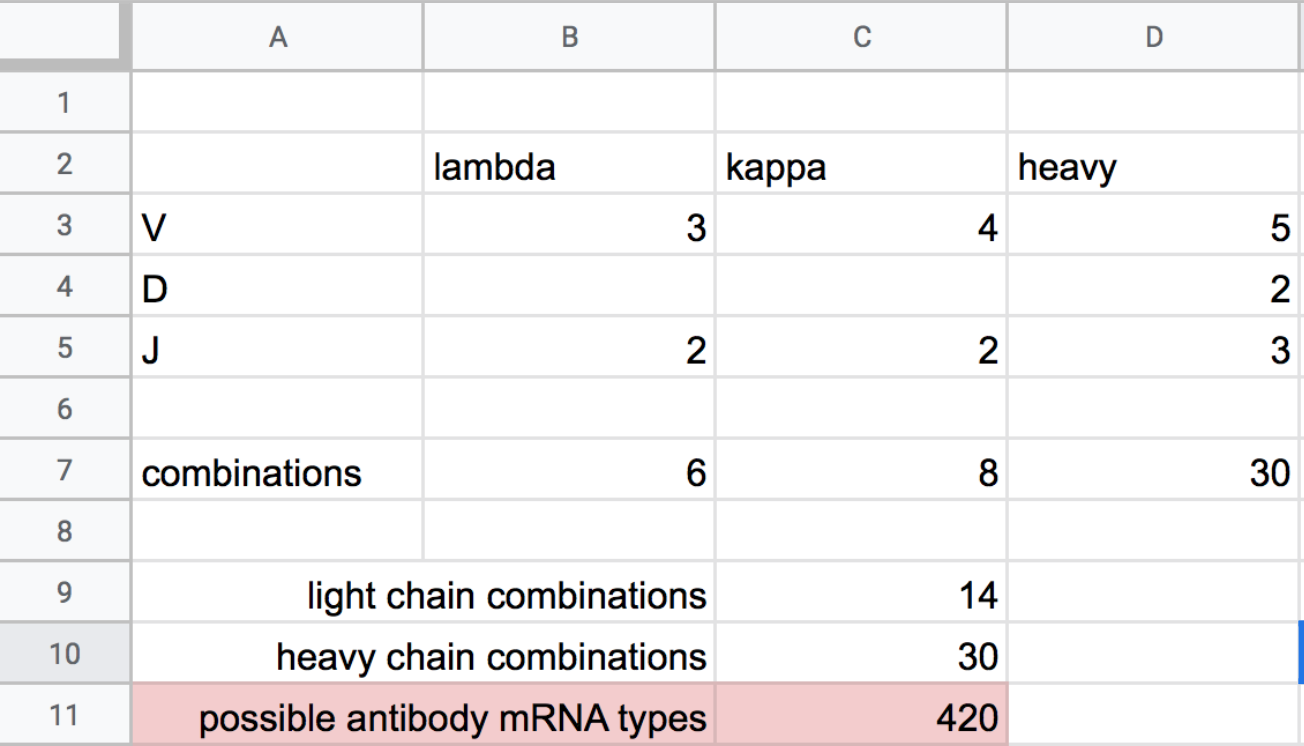Problem Set 6 Immune
Goals: combinations
How many kinds of antibody can a human make by V(D)J recombination?
An individual human produces many different antibody proteins, where “different” is amino acid sequence. How is this possible given that there are only a few “antibody” genes? Part of the answer is V(D)J recombination. An antibody is constructed from two pairs of polypeptides. Each pair consists of a light chain and a heavy chain. Each chain has a “variable” region and a “constant” region. The heavy chain is constructed from one gene (located on chromosome 14) while the light chain is constructed from two genes: the light chain locus (“lambda”) located on chromosome 22 and the light chain locus (“kappa”) located on chromosome 2. The variable region of both light chain loci is composed of a V part and a J part. The variable region of the heavy chain locus is composed of V, D, and J parts. A V, D, or J part consists of multiple copies of the exon that will be spliced into the mRNA but each of these copies has a slightly different nucleotide sequence and some of the copies do not produce functional mRNA.
To make the heavy chain mRNA for the antibody
Choose one of the copies of the V region of the heavy chain locus.
Choose one of the copies of the D region of the heavy chain locus.
Choose one of the copies of the J region of the heavy chain locus.
combine with the C (constant) region to make the heavy chain mRNA
To make the light chain mRNA for the antibody
Choose one of the copies of the V region of one (either or ) light chain locus.
Choose one of the copies of the J region of the same light chain locus.
combine with the C region to make the light chain mRNA.
Finally, combine the light and heavy chains (these are actually translated independently and then joined into the protein but the math is the same).
So an antibody is a combination of combinations. It is a combination (light + heavy combined) of combinations (V, J, and D combined)
6.1 Combinations
If there are n1 elements in set 1 and n2 elements in set 2, how many combinations of 1 element of each set are there? Answer: n1 x n2
In the table below, I use this math to compute the number of antibodies that could be made using only V(D)J recombination. The

Figure 6.1: How many kinds of antibodies
6.2 Problem set
Do these on the same sheet. Name the sheet “2. Immune”
(Ken, Jeff, David, and Doug) is the set of male faculty members in the Biology department. (Chris, Terry, Rachel1, Rachel2, and Rachel3) is the set of female faculty members in the Biology department. If the biology department has a square dance, how many combinations of male-female partners could there be? Write all of these out to confirm (write this in a column of your google sheet)
Figure 4.3 in this online textbook is a table containing the number of copies of each of the gene segments. Use this table to compute the number of different antibodies that can be synthesized using V(D)J recombination alone.